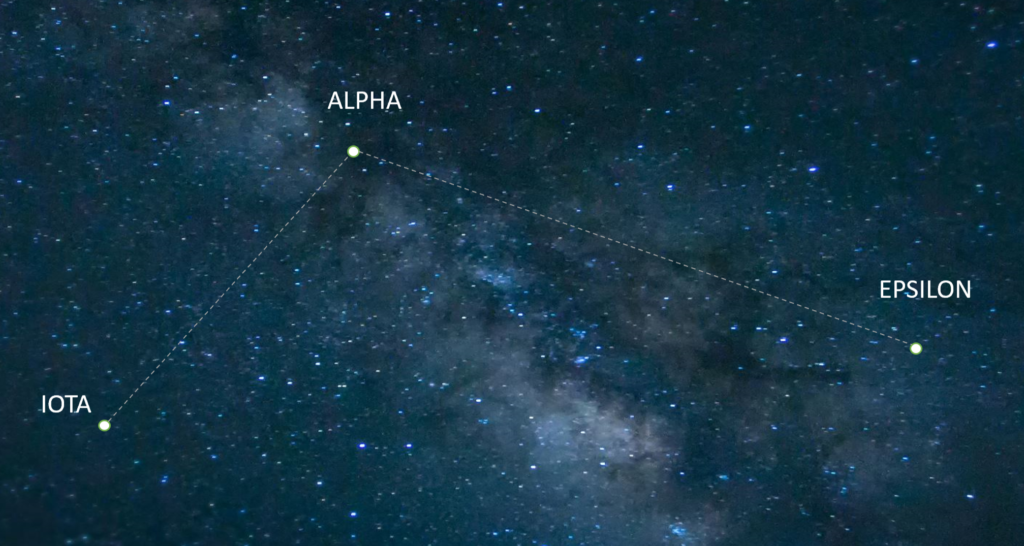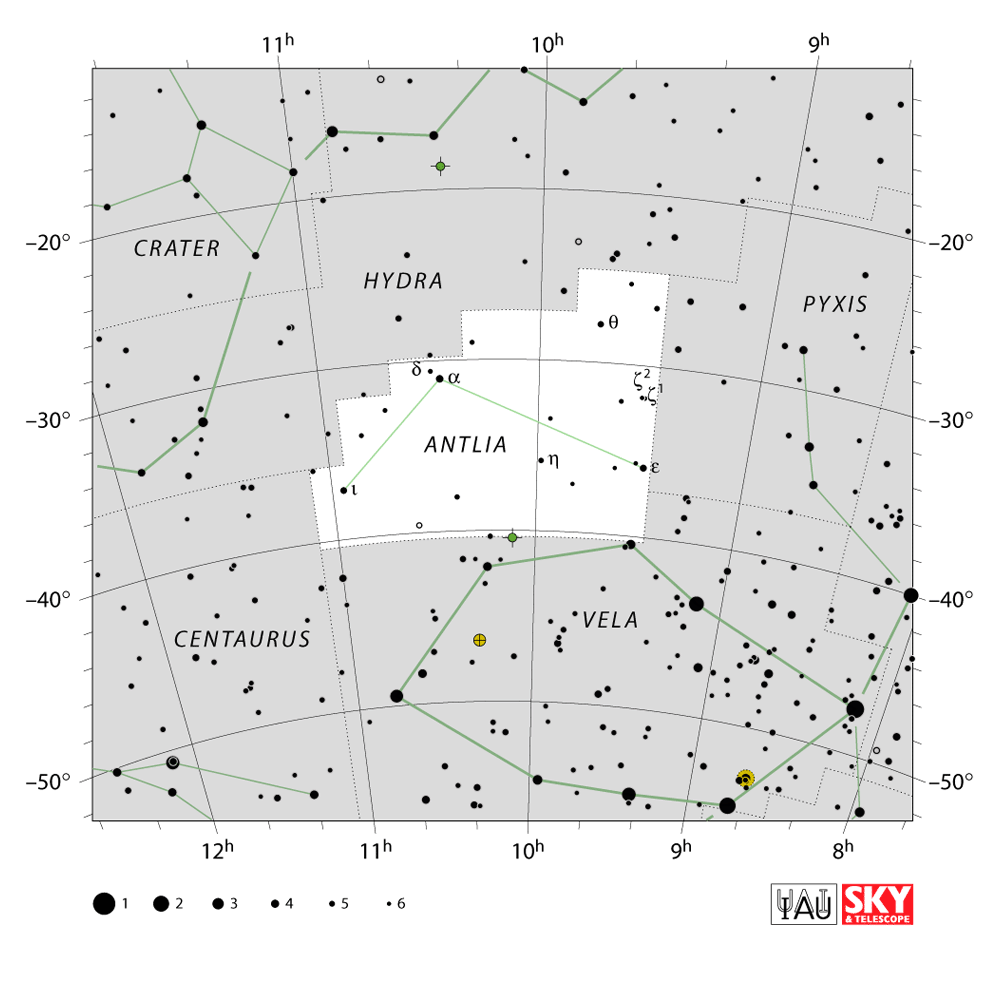Journeying through the Antlia Constellation
© NASA
Table of Contents
Antlia, situated in the Southern Celestial Hemisphere, derives its name from the Latin and Greek words for “pump,” representing an air pump. Originally designated as Antlia Pneumatica, this constellation was delineated by Nicolas-Louis de Lacaille during the 18th century. Positioned north of stars composing the sails of the ship Argo Navis (part of the Vela constellation), Antlia becomes entirely visible from latitudes south of 49 degrees north.
Recognized for its subtlety, Antlia features Alpha Antliae as its brightest star. This orange giant, suspected to be a variable star, fluctuates between apparent magnitudes 4.22 and 4.29. Notable within the constellation is the eclipsing binary star system S Antliae, where variations in brightness occur as one star passes in front of the other. These stars, sharing a common envelope, are in such close proximity that they are anticipated to merge, forming a singular star in the future.
The constellation hosts two star systems known to have exoplanets—HD 93083 and WASP-66. Additionally, it is home to NGC 2997, a spiral galaxy, and the Antlia Dwarf Galaxy, contributing to the astronomical tapestry of this understated constellation.
Nicolas-Louis de Lacaille, the French astronomer, initially characterized the constellation in French as “la Machine Pneumatique” (the Pneumatic Machine) during 1751–52. This designation commemorated the air pump invented by the French physicist Denis Papin. In Lacaille’s portrayal, Antlia represented a single-cylinder vacuum pump utilized in Papin’s early experiments, while the German astronomer Johann Bode opted for the more advanced double-cylinder version.
Despite being visible to the Ancient Greeks, the stars of Antlia were too faint to be widely recognized as a figurative object or a component of one in ancient asterisms. The stars that now form Antlia were situated in a region of the sky associated with the asterism/old constellation Argo Navis, the ship of the Argonauts. Over time, due to its vast size, Lacaille divided Argo Navis into its constituent parts—hull, poop deck, and sails—in 1763. Notably, Ridpath notes that owing to their faintness, the stars of the constellation were not included in the classical depiction of Argo Navis.
Encompassing 238.9 square degrees, equivalent to 0.579% of the sky, Antlia holds the 62nd position among the 88 modern constellations in terms of area. Situated in the Southern Celestial Hemisphere, the entire constellation becomes visible to observers south of 49°N. Hydra, resembling a sea snake, stretches along its northern border, with Pyxis (the compass), Vela (the sails), and Centaurus (the centaur) aligning to the west, south, and east, respectively. Designated by the International Astronomical Union as “Ant,” the constellation’s official boundaries, defined by Belgian astronomer Eugène Delporte in 1930, form a polygon with twelve sides. In the equatorial coordinate system, these borders span right ascension coordinates between 09h 26.5m and 11h 05.6m, and declination coordinates between −24.54° and −40.42°.
STAR DETAILS

Antlia, the Air Pump constellation, is a small and faint constellation in the southern hemisphere. While it lacks particularly bright stars, there are a few notable ones within its boundaries:
ALPHA ANTLIAE
Alpha Antliae, the brightest star in the constellation, adds a touch of subdued brilliance to the southern celestial hemisphere. Classified as an orange giant, this stellar luminary graces the night sky with its modest radiance. Suspected to be a variable star, Alpha Antliae subtly fluctuates between apparent magnitudes 4.22 and 4.29, captivating observers with its nuanced luminosity. While it may not shine as brightly as some celestial beacons, Alpha Antliae stands as a key stellar resident in the quiet expanse of the Antlia constellation.
IOTA ANTLIAE
Iota Antliae, residing in the constellation, contributes its subtle glow to the celestial tapestry of the southern skies. As a part of this unassuming constellation, Iota Antliae is a binary star system that may lack the luminosity of its counterparts in more prominent cosmic regions. Despite its faintness, Iota Antliae intrigues astronomers with its unique characteristics, adding a modest yet distinctive layer to the astronomical narrative within the constellation.
EPSILON ANTLIAE
Epsilon Antliae, a yellow-white dwarf star nestled within the constellation, graces the southern celestial hemisphere with its modest radiance. While not among the brightest in the night sky, Epsilon Antliae holds its own allure. Visible without optical aids, its subtlety adds a touch of charm to the cosmic tapestry. As a stellar inhabitant of the constellation, Epsilon Antliae provides observers with a glimpse into the understated beauty of the southern skies. Its position within this constellation encourages stargazers to appreciate the nuances of a celestial body that may not shine as brightly as some but contributes to the overall quiet elegance of the southern cosmic panorama.
DEEP-SKY OBJECTS

The Antlia constellation is not particularly known for hosting numerous deep-sky objects, and it lacks the prominent galaxies, nebulae, and star clusters found in some other regions of the night sky. However, there are a couple of notable objects within its boundaries:
ANTILA DWARF GALAXY (PGC 29194)
The Antlia Dwarf Galaxy, a celestial gem residing in the southern celestial hemisphere, stands as a testament to the rich diversity within our cosmic neighbourhood. Discovered within the boundaries of the unassuming Antlia constellation, this dwarf irregular galaxy adds a touch of astronomical intrigue to the vast cosmic tapestry.
Situated approximately 4 million light-years away from Earth, the Dwarf Galaxy is a member of the Local Group, a galactic gathering that includes our own Milky Way. Despite its faint luminosity, this diminutive galactic companion holds profound significance in the realm of astrophysics. Its study provides astronomers with valuable insights into the dynamics, structure, and evolution of smaller galactic systems.
The Antlia Dwarf Galaxy’s unassuming appearance belies its cosmic importance. Its relatively low surface brightness makes it a challenging target for observers, requiring patience and keen observational skills to discern its delicate glow. However, advancements in observational technologies, including sensitive telescopes and specialized detectors, have allowed astronomers to delve deeper into the mysteries concealed within its faint stellar population.
In terms of morphology, the Antlia Dwarf Galaxy exhibits characteristics typical of irregular galaxies, lacking the organized spiral or elliptical structure seen in larger galactic counterparts. Its stellar constituents, although modest in number, contribute to the ongoing narrative of galactic evolution and the interconnected nature of celestial objects.
NGC 2997
NGC 2997, a celestial masterpiece residing in the southern skies within the constellation, captures the imagination of astronomers and stargazers alike. This spiral galaxy, approximately 30 million light-years away from Earth, stands as a testament to the breathtaking diversity of cosmic wonders within our observable universe.
With its distinctive spiral arms gracefully extending into space, NGC 2997 paints a mesmerizing portrait on the astronomical canvas. The galaxy’s morphology aligns it with the category of barred spiral galaxies, featuring a central bar-shaped structure that extends outward into magnificent spirals. This intricate configuration of stars, gas, and dust contributes to the galaxy’s captivating visual appeal.
NGC 2997’s celestial dance unfolds within the cosmic theatre of the constellation, adding to the allure of this often-overlooked region of the night sky. Although it may not boast the visibility of some more prominent deep-sky objects, its significance lies in its contribution to our understanding of galactic dynamics and evolution.
Observing NGC 2997 provides astronomers with a glimpse into the complexities of galactic structure and star formation processes. The detailed study of its spiral arms, stellar populations, and interstellar medium unveils clues about the mechanisms driving the cosmic symphony of stars within the galaxy.
OBSERVATION TIPS

Observing the Antlia constellation can be challenging due to its faint stars and lack of prominent deep-sky objects. However, for those interested in exploring this region of the southern hemisphere’s night sky, here are some observation tips:
DARK SKY LOCATION
Choose a dark sky location away from city lights and light pollution to enhance visibility. The faintness of Antlia’s stars makes it especially important to minimize light interference.
USE BINOCULARS OR TELESCOPES
Antlia’s stars are generally faint, so using binoculars or a telescope is recommended for better visibility. A telescope with a wide field of view can help capture more of the constellation’s area.
FOCUS ON BINARY STARS
The constellation does contain binary star systems, and observing these can be interesting. Alpha Antliae, for example, is a binary system that may be observed with optical aids.
KNOW THE SURROUNDING CONSTELLATIONS
Familiarize yourself with the surrounding constellations, such as Hydra and Vela, to aid in locating Antlia. Identifying neighbouring stars and constellations can serve as helpful reference points.
PATIENCE AND DARK ADAPTION
Given the faintness of Antlia’s stars, patience and dark adaptation of your eyes are crucial. Allow your eyes to adjust to the darkness for at least 15-20 minutes to improve sensitivity.
USE STAR CHARTS OR APPS
Utilize star charts or astronomy apps to help identify the stars and patterns within the constellation. These tools can guide you in navigating the faint celestial features.
EXPLORE ANTILA DWARF GALAXY
While challenging due to its faintness, consider attempting to observe the Antlia Dwarf Galaxy. Use a telescope with a sufficient aperture and dark skies for the best chances of spotting this dwarf irregular galaxy.
OBSERVE DURING OPTIMAL VIEWING TIME
The constellation is best observed during the southern hemisphere’s spring and early summer months when it is higher in the night sky. Check the visibility times for your specific location and plan your observations accordingly.
